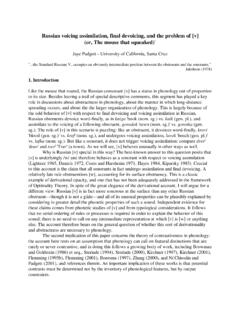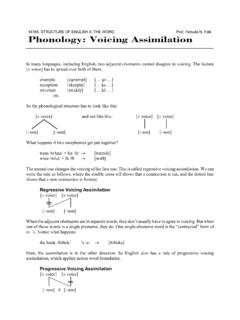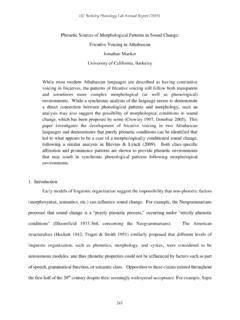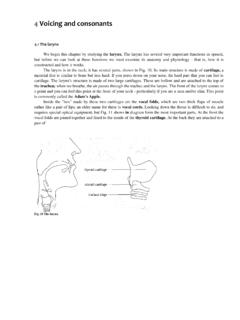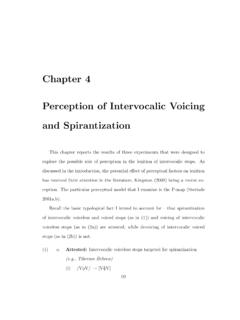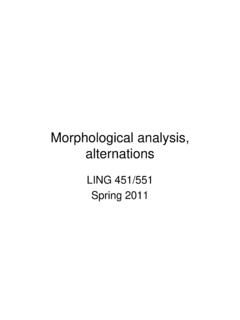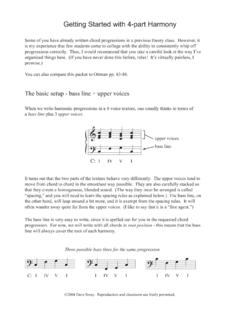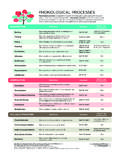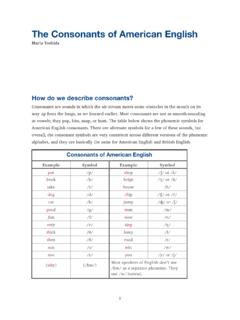Transcription of L. “DROP 2” VOICINGS - opus28.co.uk
1 Extract from A Compendium of Jazz Piano VOICINGS Jason Lyon 2007, drop 2 VOICINGSB ebop, hard bop, contemporary Evans, Barry Harris, Oscar Peterson, Kenny ARRANGING technique used when voicing for four horns. The basicapproach is to take the third and sixth VOICINGS (aka four-way close) and drop the second from top tone down an octave. But you can actually applythe drop 2 method to any of the four-note VOICINGS we ve looked at, in anyinversion. Some examples: Dm7 Dm7F7+11 Eb6 thirds rootless mel min grip 6th voicingIt s most common to take the top three tones in the right hand and thedropped tone in the left. This makes it easier to add emphasis to the dropped voice by playing it louder or by rolling chromatically up or downto it. You could also play three notes in the LH, one with the RH thumb andadd a melody note on top.
2 (Oh, and if you think about it for a bit, you couldalso regard drop 2 as raise 3 , just of a different inversion of the chord.) drop 2 is a great way of taking the girl tied to railway tracks melodramaout of 7b9 VOICINGS : G7 adjusted to G7b9 .. drop 2 (all inversions)48 Extract from A Compendium of Jazz Piano VOICINGS Jason Lyon 2007, CHORDS IIDROP 2 JUST AS we interwove close position 7b9 and 6th chords for the basic four-way close block chord style, we can do the same with drop 2 VOICINGS for aricher, more spread block chord style as used by Barry Harris and manyothers. The following block chords are the same as four-way close, but withthe second voice dropped an octave:C6 ( drop 2)Cm6 ( drop 2)Cm7 ( drop 2)49 Extract from A Compendium of Jazz Piano VOICINGS Jason Lyon 2007, ( drop 2)These lines can be quite confusing to read and internalise. The best way tolearn them is to pick a tune where part of the melody moves by scale tones(good examples are Solar, Lullabye of Birdland, There Will Never Be Another You,Mr PC don t worry about the tempo, we re not going to play them up tospeed).
3 Practise the scalar part of the tune first in four-way close in the RHonly, then in drop 2, leaving the dropped tone out of the RH and playing itdown the octave in the LH t get hung up on trying to voice entire tunes in block chords. Too muchof this chordal sound is too rich harmonically too dense especially whenthe chord changes are moving at a fast rate. Just look for snippets of tuneswhere the changes are simple enough to accommodate block chords for a baror you ve internalised a few of these lines, try dropping them into solos as little quotes to begin with, then varying the rhythm. Some pianists havedeveloped block chord soloing to an Olympian standard, but you don t haveto lock yourself away for ten years of obsessive practice to be able to use example of Miles Davis s Solar voiced in blockchords is given in Chapter from A Compendium of Jazz Piano VOICINGS Jason Lyon 2007, SLASH CHORDS & POLYCHORDSC ontemporary, funk, fusion, Hancock, Joe Zawinul, Chick CHORDS are nothing more or less than a triad over an unobviousbass note, any inversions, root close-voiced or low.
4 The gesture is borrowedfrom rock and pop music is essentially triadic in character and this is reflected in the way itis notated. Pop charts are often composed entirely of triads (with theoccasional dominant 7th) and simple diatonic slash chords. The slash chordstypically indicate a 3rd or 5th in the bass (eg C/E or C/G), a sus chord (eg F/Gfor G7sus) or are used just to indicate stepwise motion in the bass linebetween chords. They are also used to indicate more complex harmony in asimplified triadic manner Fm/D, for instance, instead of D , or A/F# forF#m7. This clean-cut triadic sound may seem tame to jazz ears, but don tdismiss it out of hand it has its are lots of possibilities for using more adventurous slash chords in ajazz context, but arguably the two most useful are: E/C Bb/Cgiving C +5 C7sus (9)It s common to play triad expansions and, particularly on the sus voicing, toreinforce the bass root with an octave, 5th , 9th or 10th as in the sus voicingHerbie Hancock used on Maiden Voyage (from the album of the same name):63 Extract from A Compendium of Jazz Piano VOICINGS Jason Lyon 2007, D7sus (C/D)These sus slash chords, when close-voiced, also work as minor 11th chords onthe related II in the case of Bb/C, Gm11:You can also use fuller chords over a bass note, or chords on top of otherchords (known as polychords).
5 Some common examples:B/F = F7b9 (and Ab7b9, B7b9, D7b9) plus the diminished lot)Gm7/C = C7sus (a good way of thinking of sus chords is as a II-V inone chord C7sus F is a substitute for Gm7 C7 F )Bb /C = C7sus13G /C = C7susb9 (this is one convenient way to think of susb9chords C7susb9 is a G C7b9 progression in one chord)D = C +4, D7sus and all the other chords from G majorCand G melodic minor (NB a triad over a triad)Abm = F7b9 (and Ab7b9, B7b9, D7b9) (NB a triad over a chord) D7 These VOICINGS are often written into parts either to specify a specific voicingor as a quick aid to reading. Note also the common convention of writtenslash chords with an oblique slash and polychords with a horizontal are some very weird and wonderful possibilities available (and somejust plain weird ones), particularly with polychords. Even when the resultingvoicing doesn t make any sense when analysed as a traditional chord type,the coexistence of the triads tends to give these voicing a high degree ofpolytonal coherence which makes them appealing, particularly if you movethem around in from A Compendium of Jazz Piano VOICINGS Jason Lyon 2007, chords moving in parallel can make for a particularly exciting modernsounding way of arranging and playing.
6 Chick Corea and the late lamentedMichael Brecker have explored this compositional approach a lot. Check outthe intro to Brecker s Not Ethiopia and the pickup to The Crusaders Street Lifefor innovative uses of slash chord motion. ECM-style tunes also makefrequent use of slash and are a couple of examples often used as reharmonisations for a I chord(most commonly, but not exclusively, at the end of a tune). Instead of C , wecould play: B/C Eb7 13 DbYou might think of describing the first one as a sort of diminished Lydian(hey, might be easier just to think of it as a slash chord there s a reason theycall it shorthand it s easier to write and read). The second one spells outDb +4, which has enough tones in common with C to make it a viablesubstitute. Note that we ve thickened the LH with R 5. Oh, and we can playE/C as a reharmonisation of I as Davis used the B/C type slash chord a lot, as a final I in the Workin/Steamin/Relaxin Quintet and more extensively on In A Silent Way.
7 The Dbvoicing is often left as is, but it can be smoothly resolved to C by dropping thelower notes by a semitone: Db +4 C 65 Extract from A Compendium of Jazz Piano VOICINGS Jason Lyon 2007, approachThe whole voicing is shifted up or down, and adapted where necessary tostay within the chord-scale. We ve seen this sort of thing before with thefourth VOICINGS and So What VOICINGS used in rides:Eb +4 FourthsSo WhatIn both examples we ve used the Lydian chord-scale to get round the avoidnote (Ab, the natural 4th) you can turn a chord into a +4 whenever youlike, since the soloist is usually only ever going to play the natural 4th as apassing note. A subtler, smoother sound can be achieved with this kind ofapproach by leaving the top note unaltered:Eb +4 Fourths (adjusted) So What (adjusted)Sometimes this technique involves using different voicing types of differentchords: Cm7 F7 Fsus Fourths82 Extract from A Compendium of Jazz Piano VOICINGS Jason Lyon 2007, approachThe whole voicing is shifted exactly as is, without worrying about whetherthe shifted voicing stays within the chord-scale.
8 You can move up or down bysemitone or tone: semitone E approach C7 US IIThis particular example is often used in places such as the first chord of Stella,where it gives you something good to play over the pickup note to themelody. But don t forget it can be used over all the chords from the parent Gmelodic approaches involving non-chord tones are concerned, it s best not tolinger too long on the approaching voicing or you can create some fearfulharmonic clashes against what the rest of the band is doing. Treat parallelapproaches the same way you d treat passing tones in a solo line ie, don tplace them on strong beats or hold them against the underlying good way to begin getting into approaches is to wait for a bit of space in themelody or solo and sashay your voicing up-and-down or down-and-up:Eb Fourths drop 2 Which is a good way to add interest to situations such as the A section ofGreen Dolphin Street in fact, this tune is a great testing ground for learningapproaches, since the version Miles Davis popularised uses four chordsmoving completely in parallel.
9 Parallel approaches work best when thewritten chords sit and breathe for a whole bar or from A Compendium of Jazz Piano VOICINGS Jason Lyon 2007, approachThis is an extension of block-chord logic where non-chord tones are voiced asdominants. Play a voicing for the V of the chord you re approaching (not thekey the tune is in) to move a tone or semitone up or down. Of course, onceyou ve added a dominant, you can alter it any number of different ways. Forinstance: C7alt F C7 F US b IIIm drop 2 13th 3rdsAgain, there are plenty of possibilities for keeping the top tone the same,using different voicing types. For instance: G7b9 C US VI So What84 Extract from A Compendium of Jazz Piano VOICINGS Jason Lyon 2007, third approachMinor 3rd approach is just one version of parallel approach. We ve noted thatwhen VOICINGS are from a diminished scale they can move up or down byminor thirds.
10 So when you see a V-I in a chord chart, you can treat the V as7b9 and play this sort of thing: Bb7b9 Eb 7b 9 Slash Chords Axis Db/D Bb/B G/Ab E/FYou don t have to use all four 7b9 slash chords (but it s as well to practisethem all together like this), and you can also use them ascending. Oh, and byvarying which 7b9 slash chord you end on, you ll find you can resolvesmoothly to any chord tone on the chord that , you could play the same thing when the written progression is Fm7Bb7 Eb it s not uncommon for pianists to just ignore the II chord in thesecontexts. But you d rarely do this under a soloist, and only under the melodywhen you re sure it s not going to clash. If you re soloing or you have the fillduring a turnaround, it s can also move up by a minor 3rd when playing over a minor II-V. Forinstance, E is from G melodic minor and A7alt is from Bb melodic minor aminor 3rd higher.








